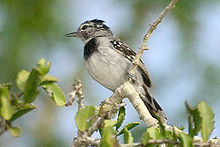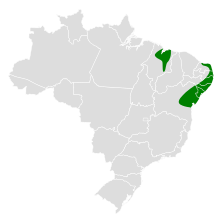394:
198:
77:
436:
known to determine precise threats, but clearance for irrigated and dry field agriculture has removed extensive tracts of deciduous forest." "Intensive grazing and extensive burning are widespread throughout its range." It occurs in only one small protected area, in
Sergipe. "Systematic surveys needed in order to determine true extent of the species’ range and population, as well as the best locations for creation of multiple small reserves."
52:
372:. It typically feeds between 2.5 and 7 m (8 and 23 ft) above the ground and sometimes as high as 12 m (40 ft). It rarely feeds on the ground. It forages actively and methodically, and usually captures prey by gleaning from leaves, stems, and vines by reaching and sometimes lunging from a perch. It often also makes short sallies to hover-glean. It is not known to follow
33:
298:
and white-tipped uppertail coverts. Their wings are black with white-tipped coverts and flight feathers with white edges towards the end. Their innermost tail feathers are black with white edges, the outermost entirely white, and those in between black with white tips. Their throat and underparts are
435:
originally in 1988 assessed the pectoral antwren as
Threatened and since 1994 as Vulnerable. It has a fragmented distribution within its range, especially in Maranhão. Its estimated population of between 2500 and 10,000 mature individuals is believed to be decreasing. "It is still insufficiently
574:
Remsen, J. V., Jr., J. I. Areta, E. Bonaccorso, S. Claramunt, G. Del-Rio, A. Jaramillo, D. F. Lane, M. B. Robbins, F. G. Stiles, and K. J. Zimmer. Version 26 November 2023. A classification of the bird species of South
America. American Ornithological Society.
299:
mostly white with a black patch on the breast and gray sides and flanks. Adult females have a rufous crown, brownish olive upperparts, buffish edges on their flight feathers, and buff sides of their neck and their underparts. Their tail is like the male's.
422:
The pectoral antwren's song is a "high, very fast chattering series of 'tututjdrrrrrr' notes, which rise rather sharply at the start and may finish slightly falling-off to an abrupt ending". Its call is "a flat 'caa' ".
368:
The pectoral antwren's diet has not been detailed but includes insects and probably spiders. It forages singly, in pairs, and in family groups, and often as a member of a
605:), version 1.0. In Birds of the World (J. del Hoyo, A. Elliott, J. Sargatal, D. A. Christie, and E. de Juana, Editors). Cornell Lab of Ornithology, Ithaca, NY, USA.
798:
837:
286:
The pectoral antwren is 11 to 12 cm (4.3 to 4.7 in) long. Adult males have a black crown and nape with white spots around the former, a long whitish
384:
The pectoral antwren's breeding season has not been defined but includes August and
September. Nothing else is known about the species' breeding biology.
917:
772:
811:
942:
633:
937:
932:
347:. It does not favor any particular stratum of the forest. In elevation it ranges from sea level to 850 m (2,800 ft).
927:
816:
652:
76:
701:
369:
842:
715:
507:
850:
855:
922:
723:
663:
308:
171:
482:
259:. Its relationship to others of its genus is unclear but it apparently is most closely related to the
260:
312:
245:
41:
217:
71:
56:
327:. In both areas the species occurs only locally. The Maranhão population inhabits deciduous and
803:
546:"Descriptions of twelve new or little-known species of the South American family Formicariidae"
197:
876:
829:
746:
629:
881:
557:
511:
477:
344:
728:
894:
863:
407:
459:
561:
541:
328:
249:
225:
187:
576:
911:
824:
468:
253:
148:
61:
751:
515:
393:
268:
738:
360:
The pectoral antwren is thought to be a year-round resident throughout its range.
785:
695:
545:
324:
287:
686:
32:
889:
295:
275:
128:
88:
868:
680:
606:
373:
339:
333:
108:
294:. Their back and rump are gray with a black and white patch between the
777:
316:
291:
229:
138:
790:
710:
233:
98:
764:
657:
759:
320:
432:
221:
118:
661:
311:. One population is found in far northeastern Brazil from
290:, a narrow black streak through the eye, and grayish ear
267:), and at least one author has considered them to form a
628:. New York: Oxford University Press. pp. 246–247.
601:
Zimmer, K. and M.L. Isler (2020). Pectoral
Antwren (
670:
577:
https://www.museum.lsu.edu/~Remsen/SACCBaseline.htm
483:10.2305/IUCN.UK.2017-3.RLTS.T22701577A118816985.en
387:
550:Proceedings of the Zoological Society of London
8:
337:woodlands, and further south inhabits tall
658:
619:
617:
615:
597:
595:
593:
591:
589:
587:
585:
196:
50:
31:
22:
502:
500:
481:
408:Listen to pectoral antwren on xeno-canto
445:
607:https://doi.org/10.2173/bow.pecant1.01
453:
451:
449:
224:in subfamily Thamnophilinae of family
331:. In Rio Grande do Norte it inhabits
7:
626:A Field Guide to the Birds of Brazil
469:IUCN Red List of Threatened Species
562:10.1111/j.1096-3642.1857.tb01217.x
14:
918:IUCN Red List vulnerable species
392:
323:. The other is somewhat west in
228:, the "typical antbirds". It is
75:
458:BirdLife International (2017).
252:in 1857 and given its current
1:
943:Taxa named by Philip Sclater
653:BirdLife Species Factsheet.
579:retrieved November 27, 2023
370:mixed-species feeding flock
307:The pectoral antwren has a
959:
476:: e.T22701577A118816985.
248:by the English zoologist
244:The pectoral antwren was
195:
177:
170:
72:Scientific classification
70:
48:
39:
30:
25:
895:Herpsilochmus-pectoralis
716:herpsilochmus-pectoralis
702:Herpsilochmus pectoralis
672:Herpsilochmus pectoralis
603:Herpsilochmus pectoralis
462:Herpsilochmus pectoralis
303:Distribution and habitat
274:The pectoral antwren is
257:Herpsilochmus pectoralis
240:Taxonomy and systematics
213:Herpsilochmus pectoralis
181:Herpsilochmus pectoralis
938:Birds described in 1857
933:Endemic birds of Brazil
624:van Perlo, Ber (2009).
609:retrieved March 3, 2024
514:, eds. (January 2024).
542:Sclater, Philip Lutley
928:Birds of the Caatinga
343:woodlands and mature
309:disjunct distribution
261:large-billed antwren
246:originally described
520:IOC World Bird List
313:Rio Grande do Norte
42:Conservation status
510:; Donsker, David;
460:"Pectoral Antwren
218:Vulnerable species
163:H. pectoralis
905:
904:
877:Open Tree of Life
664:Taxon identifiers
635:978-0-19-530155-7
512:Rasmussen, Pamela
414:
413:
319:and northeastern
204:
203:
65:
26:Pectoral antwren
950:
898:
897:
885:
884:
872:
871:
859:
858:
846:
845:
833:
832:
820:
819:
807:
806:
794:
793:
781:
780:
768:
767:
755:
754:
742:
741:
732:
731:
719:
718:
706:
705:
704:
691:
690:
689:
659:
640:
639:
621:
610:
599:
580:
572:
566:
565:
538:
532:
531:
529:
527:
504:
495:
494:
492:
490:
485:
455:
396:
388:
345:secondary forest
208:pectoral antwren
200:
183:
80:
79:
59:
54:
53:
35:
23:
958:
957:
953:
952:
951:
949:
948:
947:
908:
907:
906:
901:
893:
888:
880:
875:
867:
864:Observation.org
862:
854:
849:
841:
836:
828:
823:
815:
810:
802:
797:
789:
784:
776:
771:
763:
758:
750:
745:
737:
735:
727:
722:
714:
709:
700:
699:
694:
685:
684:
679:
666:
649:
644:
643:
636:
623:
622:
613:
600:
583:
573:
569:
540:
539:
535:
525:
523:
506:
505:
498:
488:
486:
457:
456:
447:
442:
429:
420:
415:
410:
405:
404:
402:Songs and calls
382:
366:
358:
353:
305:
284:
265:H. longirostris
242:
191:
185:
179:
166:
74:
66:
55:
51:
44:
17:
16:Species of bird
12:
11:
5:
956:
954:
946:
945:
940:
935:
930:
925:
920:
910:
909:
903:
902:
900:
899:
886:
873:
860:
847:
834:
821:
808:
795:
782:
769:
756:
743:
733:
720:
707:
692:
676:
674:
668:
667:
662:
656:
655:
648:
647:External links
645:
642:
641:
634:
611:
581:
567:
533:
496:
444:
443:
441:
438:
428:
425:
419:
416:
412:
411:
406:
400:
398:
386:
381:
378:
365:
362:
357:
354:
352:
349:
329:gallery forest
304:
301:
283:
280:
250:Philip Sclater
241:
238:
226:Thamnophilidae
202:
201:
193:
192:
186:
175:
174:
168:
167:
160:
158:
154:
153:
146:
142:
141:
139:Thamnophilidae
136:
132:
131:
126:
122:
121:
116:
112:
111:
106:
102:
101:
96:
92:
91:
86:
82:
81:
68:
67:
49:
46:
45:
40:
37:
36:
28:
27:
15:
13:
10:
9:
6:
4:
3:
2:
955:
944:
941:
939:
936:
934:
931:
929:
926:
924:
923:Herpsilochmus
921:
919:
916:
915:
913:
896:
891:
887:
883:
878:
874:
870:
865:
861:
857:
852:
848:
844:
839:
835:
831:
826:
822:
818:
813:
809:
805:
800:
796:
792:
787:
783:
779:
774:
770:
766:
761:
757:
753:
748:
744:
740:
734:
730:
725:
721:
717:
712:
708:
703:
697:
693:
688:
682:
678:
677:
675:
673:
669:
665:
660:
654:
651:
650:
646:
637:
631:
627:
620:
618:
616:
612:
608:
604:
598:
596:
594:
592:
590:
588:
586:
582:
578:
571:
568:
563:
559:
555:
551:
547:
543:
537:
534:
521:
517:
513:
509:
503:
501:
497:
484:
479:
475:
471:
470:
465:
463:
454:
452:
450:
446:
439:
437:
434:
426:
424:
417:
409:
403:
399:
397:
395:
390:
389:
385:
379:
377:
375:
371:
363:
361:
355:
350:
348:
346:
342:
341:
336:
335:
330:
326:
322:
318:
314:
310:
302:
300:
297:
293:
289:
281:
279:
277:
272:
270:
266:
262:
258:
255:
254:binomial name
251:
247:
239:
237:
235:
231:
227:
223:
219:
215:
214:
209:
199:
194:
189:
184:
182:
176:
173:
172:Binomial name
169:
165:
164:
159:
156:
155:
152:
151:
150:Herpsilochmus
147:
144:
143:
140:
137:
134:
133:
130:
129:Passeriformes
127:
124:
123:
120:
117:
114:
113:
110:
107:
104:
103:
100:
97:
94:
93:
90:
87:
84:
83:
78:
73:
69:
63:
58:
47:
43:
38:
34:
29:
24:
21:
19:
671:
625:
602:
570:
556:: 129–133 .
553:
549:
536:
524:. Retrieved
519:
487:. Retrieved
473:
467:
461:
430:
421:
418:Vocalization
401:
391:
383:
367:
359:
338:
332:
306:
285:
273:
269:superspecies
264:
256:
243:
212:
211:
207:
205:
180:
178:
162:
161:
149:
20:
18:
851:Neotropical
786:iNaturalist
696:Wikispecies
508:Gill, Frank
288:supercilium
282:Description
188:Sclater, PL
912:Categories
890:Xeno-canto
516:"Antbirds"
440:References
57:Vulnerable
526:4 January
374:army ants
315:south to
296:scapulars
276:monotypic
157:Species:
95:Kingdom:
89:Eukaryota
830:22701577
804:10459484
729:22701577
724:BirdLife
687:Q1035712
681:Wikidata
544:(1857).
522:. v 14.1
380:Breeding
356:Movement
351:Behavior
340:caatinga
334:restinga
325:Maranhão
135:Family:
109:Chordata
105:Phylum:
99:Animalia
85:Domain:
62:IUCN 3.1
882:3598983
856:pecant1
843:2591755
778:2490108
765:pecant1
739:pecant1
489:3 March
364:Feeding
317:Sergipe
292:coverts
230:endemic
216:) is a
145:Genus:
125:Order:
115:Class:
60: (
817:560414
711:ARKive
632:
427:Status
234:Brazil
190:, 1857
869:74363
799:IRMNG
791:15776
760:eBird
752:3L3HC
736:BOW:
321:Bahia
838:NCBI
825:IUCN
812:ITIS
773:GBIF
630:ISBN
528:2024
491:2024
474:2017
433:IUCN
431:The
222:bird
206:The
119:Aves
747:CoL
558:doi
478:doi
232:to
220:of
914::
892::
879::
866::
853::
840::
827::
814::
801::
788::
775::
762::
749::
726::
713::
698::
683::
614:^
584:^
554:25
552:.
548:.
518:.
499:^
472:.
466:.
448:^
376:.
278:.
271:.
236:.
638:.
564:.
560::
530:.
493:.
480::
464:"
263:(
210:(
64:)
Text is available under the Creative Commons Attribution-ShareAlike License. Additional terms may apply.

